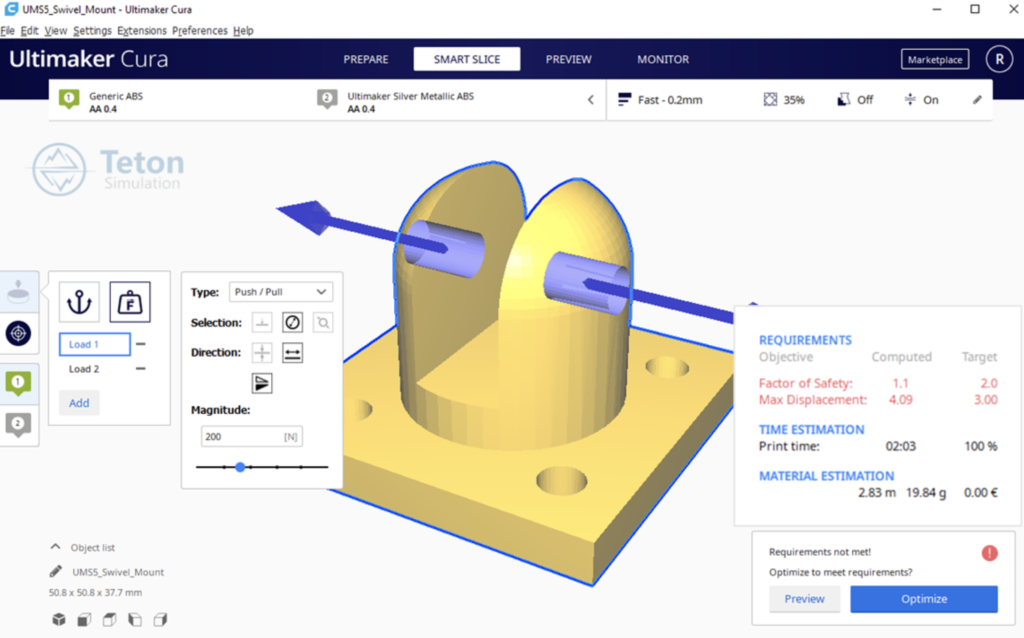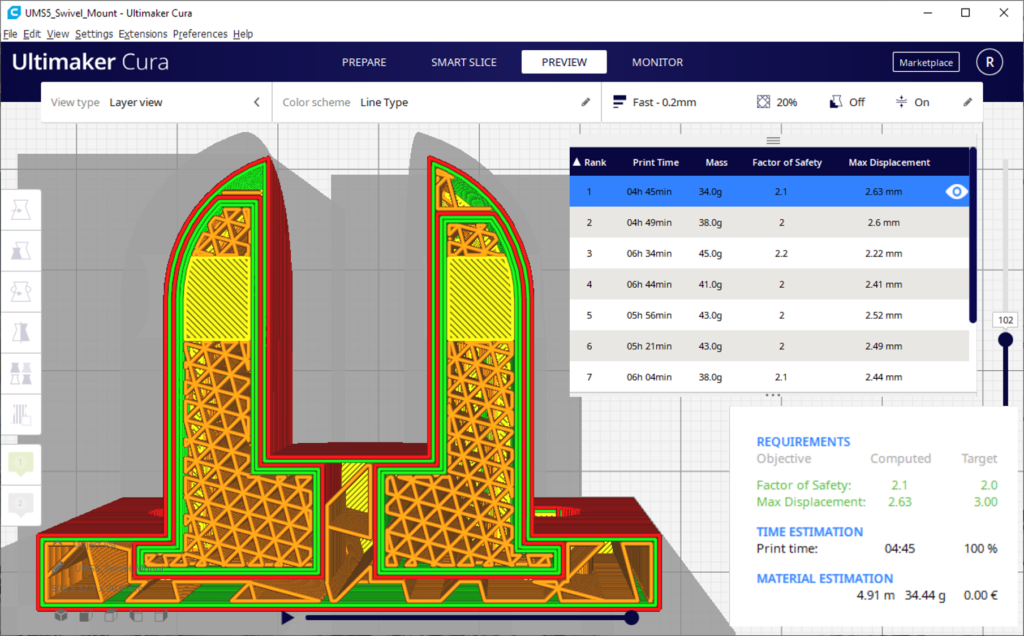Teton Simulation Software has made its product Smart Slice for Ultimaker Essentials available. Ultimaker Essentials is meant for enterprise customers and includes Cura Enterprise, Ultimaker Digital Factory (that lets you manage print farms), and an Ultimaker Marketplace for plugins. Teton’s Smart Slice product can optimize print settings, speed and material.
By offering simulation, it can save users time in getting a first part right. The software analyzes your model to determine if it is, perhaps, over-designed or under-designed. The package then looks at whether or not your part is structurally sound. It then looks at the mass of your part and print time to see if it can optimize those factors.

You can use it right within Cura. After opening a part you can define your requirements and it will then be analyzed. The software then generates a list of profiles for you to choose to print from. Smart Slice uses a physics simulation tool to evaluate the part.
“Let’s focus on infill density for the moment. Imagine that a part is required to have a factor of safety equal to 2. We can think of this as requiring the part to be twice as strong as it needs to be in operation. What infill density should we use to obtain the desired part strength?
“Suppose that we would like to see if an infill density of 20% would suffice. This value would result in relatively faster print times and lower material usage, but that’s useless if the part doesn’t perform. The validation capabilities in Intelligent Slicing allow us to leverage simulation inside the slicer to test the part virtually before having to print anything. If the results are positive, we can then print the part for testing with a measure of confidence that it will perform as desired. If the results are negative, we could change the infill density, validating performance along the way, until a suitable infill density is found.”
So, we don’t have to play settings jockeys anymore:
“Instead of manually tuning the print parameters, we simply enter the requirements for the part and then click a button. Teton’s software intelligently searches the space of possibilities to find valid print parameters that minimize time and material.”
This process can also create ‘modifier meshes’ that change the infill of one small section of your part in order to make the entire part stronger for example. Below, we can see a modifier mesh, which is the smaller infill pattern area. Rather than increase overall infill it will do it only where needed to save on time and material.
Smart Slice can also identify which part build orientation will produce the stiffest or strongest part. Essentially, this is a finite element analysis (FEA) tool aimed squarely at some of the key pain points in 3D printing. By simulating as-built parts and critical components, Teton can help us get to optimal parts faster. Launched just when a lot of us are going from tchotchkes to objects that need to perform in the real world, this could grow out to be a very valuable tool.

The team says that the software is easy to use, which I guess it is compared to full-on ANSYS. They also say that it is ideal for fixtures and in creating new fixtures quickly. I could see how this could make a difference, but I’m more excited about a large group of 3D printing users having access to powerful tools such as these to make real parts for the real world. There is now still a huge gulf between many thinking that “3D printing can make anything” to actually making functional components reliably and repeatably and this kind of a tool will help us cross that chasm.
Teton CEO Mike Kmetz noted about the software:
“Our Smart Slice technology was built from the ground up to give 3d printer operators near instant feedback on the viability of their project. There is simply no other solution in the industry that can provide lightning-fast, accurate feedback on the ‘as printed’ state of a part. Plus, our optimization feature takes the guesswork out of determining the right slicing parameters. We do all the work, so the user doesn’t have to. All of this capability is provided within the slicer making it very easy to use.”
The team behind Teton consists of ex-employees of Firehole, a composites simulation tool sold to Autodesk and FEA and machine learning people. Kmetz sold IDES to UL. IDES was, in essence, the definitive plastics database and now is the plastics piece of UL Prospector. So, they’re startup people, but very definitely leaning toward the very nerdy side of things. Which you can also tell from very informative posts on their blog about the thermal effects of bond strength and the trouble of topology optimization with FDM. The team has been working on this product for four years and have now released it via Essentials on a subscription model. You can try Smart Slice for free for 30 days here.
Subscribe to Our Email Newsletter
Stay up-to-date on all the latest news from the 3D printing industry and receive information and offers from third party vendors.
You May Also Like
US Army Corps of Engineers Taps Lincoln Electric & Eaton for Largest 3D Printed US Civil Works Part
The Soo Locks sit on the US-Canadian border, enabling maritime travel between Lake Superior and Lake Huron, from which ships can reach the rest of the Great Lakes. Crafts carrying...
Construction 3D Printing CEO Reflects on Being Female in Construction
Natalie Wadley, CEO of ChangeMaker3D, could hear the words of her daughter sitting next to her resounding in her head. “Mum, MUM, you’ve won!” Wadley had just won the prestigious...
Blue Laser-powered M600 3D Printer Launched by Meltio
Founded in 2019 as a joint venture between Additec and Sicnova, metal 3D printer OEM Meltio develops and manufactures high-performance and easy-to-use metal 3D printing solutions that use its patented wire-laser metal...
3D Printed Storage Tanks Cut Material Costs by 25%
In a previous article, “Concrete Dreams: Let’s Print Money, Not Houses,” we discussed how the spotlight on 3D printing homes might be misplaced. Bollards, pedestrian bridges, and concrete tanks could...






























